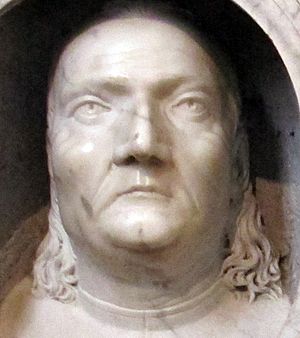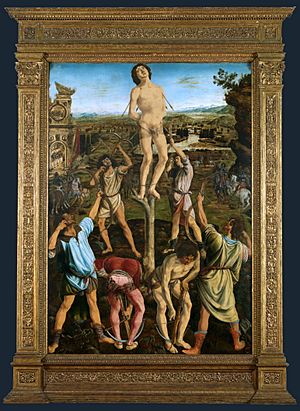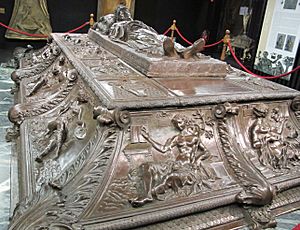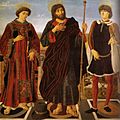Antonio del Pollaiuolo facts for kids
Quick facts for kids
Antonio del Pollaiuolo
|
|
|---|---|

Antonio del Pollaiuolo, detail of his tomb
|
|
| Born | c. 17 January 1429 or 1433 Florence, Republic of Florence
|
| Died | 4 February 1498 (aged 69) |
| Known for | Italian Renaissance painting, sculpture, engraving, goldsmithing |
|
Notable work
|
Battle of the Nudes, 2 papal tombs |
Antonio del Pollaiuolo (born January 17, 1429 or 1433 – died February 4, 1498) was a very talented Italian Renaissance painter, sculptor, engraver, and goldsmith. He created important artworks in all these areas. He also designed other items, like fancy vestments (special clothes for church ceremonies). He started his career working with metal embroidery.
Antonio's most famous works often show strong, mostly naked male figures. These figures are usually in difficult poses, doing violent actions. He was inspired by ancient Greek and Roman art. Many of his works feature the hero Hercules. Antonio, or perhaps his brother, was also good at painting wide, detailed landscapes in the background of his art. He might have learned this style from Early Netherlandish painting. His two tombs for popes were the only monuments from the old Old St Peter's church that survived. They were moved and rebuilt in the current St Peter's Basilica.
Antonio often worked with his younger brother, Piero del Pollaiolo (born around 1443 – died 1496). It's been very hard for art experts to tell which brother did what part of a work. Because of this, many paintings are simply described as being by the Pollaiuolo brothers. People at the time, including the writer Giorgio Vasari, thought Antonio was much more talented. They believed he was responsible for designing and painting most of their artworks. However, in recent years, Piero's reputation has grown. Some museums now say he alone created works like the small Apollo and Daphne (1470–1480). Still, many old lists of top artists mention both brothers together. Vasari's famous book Lives of the Artists talks about them in one chapter.
According to art historian Kenneth Clark, Antonio is less famous today for two reasons. First, his very large paintings of Labours of Hercules are now lost. Second, his name "looks difficult to pronounce." But in his own time, Antonio was seen as "one of the originating forces in the history of European art."
Contents
Antonio's Life Story
Antonio was born in Florence, a famous city in Italy. He and his brothers got the nickname pollaiuolo, which means "poulterer" in Italian. This came from their father Jacopo's job, selling poultry (like chickens). Selling poultry was a fancy business back then. Jacopo had four sons, and not all of them could work in the family business. In 1472, there were only 8 poultry sellers in Florence, but 44 goldsmith workshops.
Antonio was the oldest son. One of his middle brothers took over the poultry business. The other middle brother became a goldsmith. His youngest brother, Piero del Pollaiolo, was also an artist, mainly a painter. Antonio and Piero often worked together. Their workshops were separate but easy to get to from each other.
Their art shows influences from classical (ancient Greek and Roman) art. They were also very interested in human anatomy (how the human body is built). It's said that the brothers studied human bodies by dissections to improve their knowledge. If this is true, it would be one of the first times artists did such research in the early Renaissance.
Antonio first worked as a goldsmith and metalworker. Many people from his time said he trained in the large workshop of Lorenzo Ghiberti. This is probably true. By 1459, Antonio had his own workshop. He worked as a goldsmith and painter. Later, he also started working in sculpture and engraving. In 1464, he rented a good workshop space in Florence. He kept renewing the lease until 1493. In the following years, he took on young artists to train.
He joined the silk-workers guild in 1466. In 1469, he married his first wife, who was eighteen. He started buying land in the countryside that same year. In 1472, the two brothers and their father bought a house near their family home. They divided it into three parts, probably to rent out.
For over twenty years, Antonio had a very successful career in Florence. He rarely left the area of the Republic of Florence. By 1489, he was called the best artist in the city. Around 1484, he moved to Rome for a big project. He was asked to create a tomb for Pope Sixtus IV in St. Peter's Basilica. After that, both brothers seemed to spend most of their time in Rome, but they did visit Florence sometimes.
By 1493, Antonio had finished the first tomb. The next pope died, so Antonio stayed in Rome to make his tomb too. He made a last visit to Florence in 1496 to finish some work. He died in Rome in 1498 as a rich man. He had just finished the tomb of Pope Innocent VIII, also in St. Peter's. He was buried in the church of San Pietro in Vincoli. A monument was built there for both him and his brother, who had died in Rome two years earlier.
Antonio's move to Rome meant he avoided the difficult times in Florence after 1492. That's when Lorenzo de' Medici died, the French army invaded in 1494, and Savonarola briefly led the city.
Antonio had two daughters but no sons. However, a nephew born in 1472 worked with him. This nephew was later turned down by Michelangelo for work on the Tomb of Pope Julius II in 1507. There were some legal arguments in Florence over the money Antonio left behind. His widow gave evidence in 1511.

Antonio's Paintings
It's hard to know the exact dates of Antonio's paintings before he went to Rome. Much of his painting, especially larger pieces, was done with his brother. A group of paintings are thought to be from early in his career, before about 1466. People at the time valued Antonio's work much more than Piero's. They especially liked Antonio's disegno (drawing skill), which Antonio was probably in charge of.
Antonio was one of the first important painters to show stories from classical mythology. He often painted scenes with Hercules. The paintings of these subjects that still exist are small. They were made for private homes. Both his religious and mythological paintings are excellent at showing action. They have a "fierce air" that was unusual for the time. Before, such subjects were painted on cassone chests (large decorated boxes). But Pollaiuolo's paintings seem to have always been meant as framed pictures.
His Hercules and the Hydra (around 1475) and Hercules and Antaeus (around 1478) are now in the Uffizi Gallery in Florence. These are smaller versions of two very large paintings of the Labours of Hercules he made for the Medici Palace. These large paintings were about 3.5 meters (11.5 feet) tall. They showed figures larger than life. The third painting was Hercules and the Nemean lion. For about fifty years after they were finished, these were "amongst the most famous and influential works of their time." Sadly, they are now lost.
These large paintings were made around 1460, early in Antonio's career. They must have made him very famous as a painter in Florence and beyond. They were probably ordered by Piero di Cosimo de' Medici. They were painted on cloth, which was still quite new in Florence at that time.
Another early painting, probably from the mid-1460s, is his David with the Head of Goliath. It is now in Berlin. Unlike the famous David sculptures by Donatello, Verrocchio, or Michelangelo, this painting doesn't have any records linking it to the Florentine government or the Medici family. David is fully and richly dressed, looking more like a wealthy Florentine than a young shepherd. At 46.2 cm (18.1 in) by 34 cm (13.3 in), it was likely made for a home.
Antonio's Martyrdom of Saint Sebastian was painted with his brother. Antonio probably drew the design. It was made in 1473–1475 for a chapel in the SS. Annunziata church. It is his largest and most important surviving work. It's considered "a milestone in Renaissance art" because it was the first large painting where the figures' actions shaped the whole picture. The six large soldiers in the front are grouped in three pairs, but seen from different angles. This painting has one of the largest and most beautiful landscape backgrounds, with a river winding through it. Many of his paintings feature these detailed landscapes.
A fresco (wall painting) of dancing nude figures in a villa near Florence is in very poor condition. It might be from the 1470s. It shows Antonio's interest in extreme body poses, but this time in a happy way. This fresco was made for the Lanfredini family, who were close friends of the Medici. They seemed to be important early supporters of Antonio.
There are several similar portraits of young women, showing only their head and shoulders in profile. These are attributed to one of the brothers or their workshop.
Antonio often used an unusual method for his panel paintings. He applied paint directly to the wood, without the usual layer of gesso (a white primer). This might be why some of his paintings have lost paint over time. His main contribution to Florentine painting was his study of the human body in motion or under stress. He is also important for being one of the first to skillfully paint wide, detailed landscape backgrounds.
Antonio's Sculptures
It was not uncommon for artists in 15th-century Italy to be both painters and sculptors. Andrea del Verrocchio was another artist in Florence at the same time who had a similar career. He also started as a goldsmith, worked for the Medici, and later left Florence. The Florentine guilds (groups of skilled workers) were more flexible about this than in many other cities.
Antonio's brother Piero was not a sculptor. This means there are no questions about who made which sculptures, unlike with the paintings. Antonio and his workshop created sculptures in bronze, silver, terracotta (baked clay), plaster, and wood. However, they never seemed to work with stone. Both of his papal tombs have bronze statues. An important early project was the lower part of a silver crucifix for the main altar of the Florence Baptistery. Later, he made reliefs (carved designs) for the altar. He also made a large crucifix with the body of Christ made of painted cork. Another work was a parade shield with a relief of Milo of Croton made of gilded plaster, which is now in the Louvre museum.
Antonio was one of the sculptors who helped create the "table bronze" style. These were small bronze figures made for the palaces of wealthy people. At least three of his small bronzes were of Hercules, who also appears in several of his paintings. Two small Hercules bronzes, now in Berlin and New York, show the hero standing in a relaxed pose. But another shows the fight between Hercules and Antaeus. This sculpture "broke all the rules of sculpture" by allowing the figures to move freely in any direction needed for their actions. This bronze belonged to the Medici family in the 15th century.
Antonio also worked on a large bronze equestrian statue (a statue of a person on horseback). This statue was planned as a memorial to Francesco Sforza, Duke of Milan (died 1466). However, it was never finished.
Goldsmithing Work
Working with gold was probably Antonio's main activity for most of his career. It was also likely the most profitable part of his work. But, except for major church projects, almost none of his gold work has survived. This is normal because valuable items made for homes or smaller church pieces were often melted down and remade over the centuries. Because of their value, many lost pieces are recorded in documents, unlike his smaller paintings, which usually have no records.
Large gold projects for governments, which are now gone, include a ceremonial silver bowl in 1472. It weighed 32 pounds and had a relief of "children" inside. In 1472–1473, he made a fancy "display helmet" of silver-gilt with enamels. It had a figure of Hercules on top. This helmet was a gift for Federigo da Montefeltro, the Duke of Urbino, whom the Florentines had hired. Antonio himself might have delivered it to Urbino. In 1480, the city government ordered a silver washbowl.
In 1476, he made an enameled handle and sheath for a "bread knife" for a wealthy citizen. He would have also made many small pieces of jewelry, table settings, and small fittings. He created the silver-gilt fittings with enamel designs for the "Paris Petrarch." This was a collection of works by Petrarch ordered by Lorenzo de' Medici in 1476. The damaged enamel designs show the Muses playing instruments.
Tombs for Popes

It's amazing that Antonio's two tombs for popes were the only ones to survive when the old St. Peter's church was torn down. They were rebuilt in the current St Peter's Basilica. This shows how famous Pollaiuolo was and how good his work was. Both tombs were also very unique and new for their time.
Pope Sixtus IV started planning his tomb before he died in 1484. Antonio finished it in 1493. The tomb has a bronze statue of the pope lying down, showing him as an old person, even using a death mask. Around the statue are flat, low reliefs. These show figures representing "Theological and Cardinal Virtues" and the "Liberal Arts." The arts include "Perspective," holding an astrolabe and an oak branch, which was a symbol for Sixtus's family.
The inscriptions on the tomb include: Opus Antoni Polaioli / Florentini Arg. Auro. / Pict. Aere Clari / An. Do. MCCCCLXXXXIII". This means "The work of Antonio Pollaiuolo of Florence, famous in silver, gold, painting and bronze, AD 1493."
His second tomb for a pope was for Pope Innocent VIII. This tomb has two bronze statues. One shows the pope lying dead. The other shows him sitting on his throne, making a blessing gesture. This was the first time a pope was shown as alive on his tomb, though other tombs had used pairs of living and dead figures. Showing a figure in life became very common in later papal tombs. Originally, the living figure was at the bottom, but in 1606, the positions were swapped. The living figure holds a copy of the Holy Lance relic. This relic was given to the papacy by the Turkish Sultan during Innocent's time as pope. This tomb, Antonio's last work, originally included a self-portrait, which is now lost.
Engraving Work
Antonio only made one surviving engraving, called the Battle of the Nude Men. But this work was very important because of its size and skill. It brought Italian prints to a new level. It is still one of the most famous prints from the Renaissance. He also made a terracotta relief with a different design of such a battle. Vasari mentions both, and says Antonio made other engravings. However, Vasari might have been confused by copies made by others.
Other Artworks
Antonio designed a set of special clothes for the Florence Baptistery in the 1460s. This was a very important job. Specialists did the actual sewing, but Antonio was still paid for his design work on these items in 1480.
Writers from the 15th century praised Antonio's drawings. Other artists collected and used them as models. Later, Vasari said he owned some of Antonio's drawings, including designs for an equestrian statue. One such drawing still exists in Berlin. Fewer drawings are now thought to be by Antonio's own hand, probably less than twenty. Some of these are studies of figures, others are scenes with stories. There are also two designs on both sides of the same paper for church metalwork pieces that no longer exist. This paper is actually signed on both sides by Antonio himself, with "Antonio Pollaiuolo horafo" (Antonio Pollaiuolo goldsmith).
Images for kids
-
Portrait of a Young Woman, Museo Poldi Pezzoli, Milan.
-
Parade shield with plaster Milo of Croton, Louvre.
See also
 In Spanish: Antonio Pollaiuolo para niños
In Spanish: Antonio Pollaiuolo para niños








